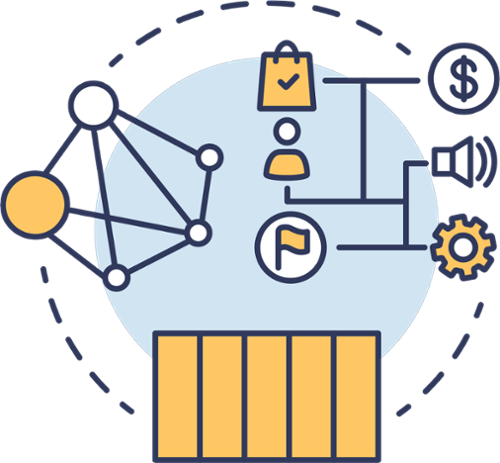
April 25, 2024 Unlocking Multi-Touch Revenue Attribution Models
The abundance of data available to marketing teams is both a valuable resource and a complex challenge. Understanding the effectiveness of each marketing touchpoint is crucial for refining strategies and enhancing the overall impact of marketing efforts. With advancements in analytics and attribution models, dissecting and comprehending multifaceted customer journeys is more important than ever. This insight enables marketing professionals to allocate resources more efficiently, optimize campaigns in real time, and substantially improve return on investment.
Multi-Touch Revenue Attribution (MTRA) models are not just theoretical concepts, but practical tools that can revolutionize your marketing efforts. They offer a nuanced and comprehensive view of how marketing contributes to revenue generation. By adopting MTRA, marketers cannot only justify their campaigns but also optimize them for better performance and ROI.
While the benefits of Multi-Touch Revenue Attribution (MTRA) models are clear, it's important to avoid a common pitfall. Many marketing teams select the attribution model that shows them the results they want to see, rather than understanding the questions each model is designed to answer. In this article, we delve into MTRA models, examining how they can be best used to evaluate marketing touchpoints and improve performance.
What is Multi-Touch Revenue Attribution?
Multi-Touch Revenue Attribution is a methodology that assigns credit to all marketing interactions a contact has across their customer journey, from the moment they enter your CRM as a lead to the point they convert into a paying customer. Unlike single-touch attribution models that credit a single interaction—often the first or last touchpoint—MTRA takes into account every touch that influenced the decision-making process, providing a more accurate representation of your marketing strategy's effectiveness.
Critical Benefits of Multi-Touch Revenue Attribution
Comprehensive Insight into the Customer Journey
MTRA models illuminate a customer's path before converting, highlighting the touchpoints that play pivotal roles at different stages of their decision-making process. This end-to-end visibility enables marketers to understand which activities drive awareness, consideration, and conversions.
Accurate Measurement of Marketing Initiatives
By distributing credit across multiple touchpoints, MTRA allows for a more balanced and precise measurement of individual marketing campaign contributions to revenue. This helps evaluate the effectiveness of different channels and strategies, paving the way for data-driven optimizations.
Enhanced Decision-Making
With a clear picture of which interactions and channels contribute most significantly to closing deals, marketers can make informed decisions about where to allocate resources for maximum impact. This optimization of marketing spend increases efficiency and boosts overall return on investment (ROI).
Connection to Revenue
The most compelling advantage of multi-touch revenue attribution models is their ability to link marketing efforts directly to generated revenue. This capability to demonstrate value in the universally understood language of deals and dollars is immensely powerful in justifying marketing budgets and strategies to stakeholders.
Illumination of Goals Beyond Revenue
While MTRA's primary focus is on attributing revenue, these models also shed light on how marketing influences other key business outcomes, such as lead generation, form submissions, and event registrations. This broader view helps in understanding the full impact of marketing beyond just the bottom line.
Types of Multi-Touch Revenue Attribution Models and Their Applications
Implementing Multi-Touch Revenue Attribution effectively requires an understanding of the various models available and their best use cases. Each model offers a unique perspective on how credit for conversions should be distributed among marketing touchpoints. Here's a breakdown of the most common MTRA models, their applications, and the insights they provide.

Linear Attribution Model
The linear attribution model equally distributes credit to every touchpoint along the customer's journey. This model is particularly useful for businesses that value holistic marketing strategies, where each interaction is considered equally important in driving the conversion.
Best Used For: Companies looking to understand the overall effectiveness of their marketing mix.
Questions It Answers:
- Which marketing channels are consistently involved in the customer journey?
- How does each touchpoint contribute to moving prospects along the conversion funnel?

Time Decay Attribution Model
The Time Decay Model assigns more credit to touchpoints closer to the time of conversion under the theory that these later interactions are more influential in the decision-making process.
Best Used For: Marketers focusing on short sales cycles or evaluating the impact of promotional campaigns close to the conversion event.
Questions It Answers:
- Which marketing efforts have the most immediate impact on conversions?
- How do the final interactions before conversion contribute to sales?

U-Shaped Attribution Model
The U-shaped model allocates more credit to the first and last touchpoints, typically assigning 40% of the credit to each, with the remaining 20% distributed among other interactions. This model emphasizes the importance of initial engagement and the final decision-making touchpoint.
Best Used For: Companies that want to understand the significance of lead generation and closing efforts in their sales cycle.
Questions It Answers:
- How meaningful are the first and last interactions in influencing customer conversions?
- What role do middle touchpoints play in nurturing potential customers?

W-Shaped Attribution Model
Expanding on the U-Shaped model, the W-Shaped Attributions Model adds additional value to a middle interaction, often identified as the opportunity creation stage.
Typically, this model assigns 30% credit to the first interaction, 30% to the lead conversion touch, 30% to the opportunity creation touch, and divides the remaining 10% among other touchpoints.
Best Used For: Businesses with complex sales processes looking to understand the impact of critical milestones in their pipeline.
Questions It Answers:
- Which interactions are most pivotal in advancing leads through the sales funnel?
- How do early, middle, and late-stage marketing efforts contribute to conversions?

Full Path Attribution Model
The Full Path Model builds on the W-shaped model by incorporating an additional stage: close.
It typically assigns credit across four key phases: lead creation, lead conversion, opportunity creation, and deal closing, with the remainder distributed among other interactions. This approach is ideal for companies with longer sales cycles and multiple key touchpoints.
Best Used For: Analyzing the efficacy of marketing strategies throughout the entire marketing and sales funnel.
Questions It Answers:
- How do interactions at each customer journey stage contribute to revenue generation?
- What is the impact of marketing efforts after the opportunity creation stage on final conversions?
Exploring the J-Shaped and Inverse J-Shaped Attribution Models
While the Linear, U-Shaped, W-Shaped, and Full Path models offer comprehensive insights into the contributions of various marketing touchpoints throughout the customer's journey, the J-Shaped and Inverse J-Shaped Attribution Models introduce a nuanced understanding of customer engagement dynamics. These models are particularly informative for businesses highlighting the importance of either the initial engagement or the concluding interactions in the conversion process.
The J-Shaped Attribution Model emphasizes the increasing significance of marketing interactions as the customer progresses towards a conversion, starting with a modest allocation of credit to initial touchpoints and dramatically increasing towards the end of the customer journey. This model is adept at recognizing efforts that build momentum and drive the customer towards making a purchase decision, making it ideal for sales strategies that escalate their persuasive force over time.
Conversely, the Inverse J-Shaped Model allocates more credit to the early stages of customer interaction, underlining the critical role of first impressions and early engagement in shaping the buyer's decision-making process. It acknowledges that the groundwork laid by initial marketing efforts can be decisive in leading to conversions, even if subsequent interactions are less intense or frequent.
Both the J-Shaped and Inverse J-Shaped models offer an alternative perspective to the more evenly distributed or milestone-focused approaches seen in other models. By understanding and applying these models, businesses can gain deeper insights into how specific stages of the customer's journey uniquely influence the path to conversion, allowing for more targeted and effective marketing strategies.

J-Shaped Attribution Model
The J-Shaped Attribution Model is terrific for those who give precedence to finders and closers, focusing more on the last touchpoint while also recognizing the impact of the initial interaction.
It assigns lesser credit to initial interaction (20%) and allocates the highest credit (60%) to the final conversion touchpoint. while dividing the remaing 20% credit to all other interactions in between
Best Used For: Companies with long sales cycles that require extensive lead nurturing and education before a purchase decision, such as in industries like software-as-a-service (SaaS) or complex B2B solutions.
Questions It Answers:
- What is the influence of final touchpoints in the effectiveness of the overall sales strategy?
- How do I give credit to the interaction that closes deals — while also acknowledging the value of lead and demand generation campaigns?

Inverse J-Shaped Attribution Model
The Inverse J-Shaped Model posits that creating awareness and fostering initial interest have a disproportionately higher impact on the customer's journey towards a conversion, while also crediting the final interaction that closes a deal.
This model is designed to recognize the critical impact of a strong first impression combined with the effectiveness of closing actions in the conversion process. It allocate more credit to the initial touchpoint (60%) for capturing customer interest and a substantial share to the final touchpoint (20%) for sealing the deal, while dividing the remaining 20% credit to all other interactions in between.
Best Used For: Companies with a relatively short sales cycle after a lead expresses interest.
Questions It Answers:
- How do I give credit to the interaction that generates demand — while also acknowledging the value of closing deals?
- How critical are first encounters in attracting and retaining customer interest?
How to Getting Started with Revenue Attribution
When implementing Multi-Touch Revenue Attribution (MTRA), it's beneficial to strategically align U-Shaped, W-Shaped, Full-Path, and Linear models in that order. Understanding the transition from one model's influence to another can present challenges, particularly in recognizing the shift in the significance of interactions from the beginning to the end of the customer's journey.
The evolution of these models progresses from focusing on initial engagement (U-shaped) to mid-journey interactions (W-shaped) and finally to the closing stages (Full-Path), with the linear model providing a comprehensive view across all touch points.
This progression enables marketers to discern how each type of content or interaction might wield more significant influence at different stages of the customer's path to purchase.
Aligning these four models helps understand how certain interactions or content may be significant in nurturing leads but might not directly correlate with conversion milestones. Conversely, if an interaction maintains a consistent impact throughout the customer's journey, it would logically receive similar attribution credit across all models applied.
This methodical approach to aligning attribution models streamlines the decision-making process for allocating marketing efforts and enriches the understanding of how different interactions contribute to conversions at each stage of the funnel.
Once you have aligned your attribution models to understand your entire sales cycle, we recommend introducing the J-Shaped and Inverse J-Shaped attribution model to look more closely at leads based on how they were entered into the CRM. The J-Shaped attribution model is excellent for anlalyzing sales prospecting leads who were imported into your CRM and introduced to your business via a Sales Rep. While the Inverse J-Shaped model is excellent for analyzing inbound, marketing generated leads who have become customers.
Conclusion
In conclusion, the judicious application of Multi-Touch Revenue Attribution (MTRA) models is paramount for businesses aiming to refine their marketing strategies and directly link marketing endeavors to revenue generation. From the Linear Attribution Model, which offers a bird's-eye view of the marketing mix's overall effectiveness, to the sophisticated Full Path Model, designed for deep dives into the customer journey across all touchpoints, selecting the appropriate MTRA model is vital for unearthing invaluable insights into marketing performance and optimizing the allocation of resources for maximal ROI.
Implementing these models can present considerable complexities and require a nuanced understanding of marketing analytics. This is where SEO Fundamentals excels. We specialize in helping businesses deploy bespoke Multi-Touch Revenue Attribution strategies that resonate with their unique operational needs and marketing objectives. By partnering with us, you gain access to our expertise in MTRAs and a comprehensive suite of marketing operations solutions designed to elevate your marketing efforts to new heights of efficiency and effectiveness.
READY TO TRANSFORM YOUR BUSINESS?
Book a Free Consultation & Learn how we can help your business grow.
Warren Claflin
With over a decade of web development and digital marketing experience earned within the fintech, professional services, and B2B, Warren Claflin is a seasoned expert crafting and executing data-driven marketing strategies focused on growing inbound leads. Warren excels in PPC, inbound marketing, and digital advertising, standing out for his resilience and forward-thinking approach to navigating industry shifts and leading recovery strategies.

